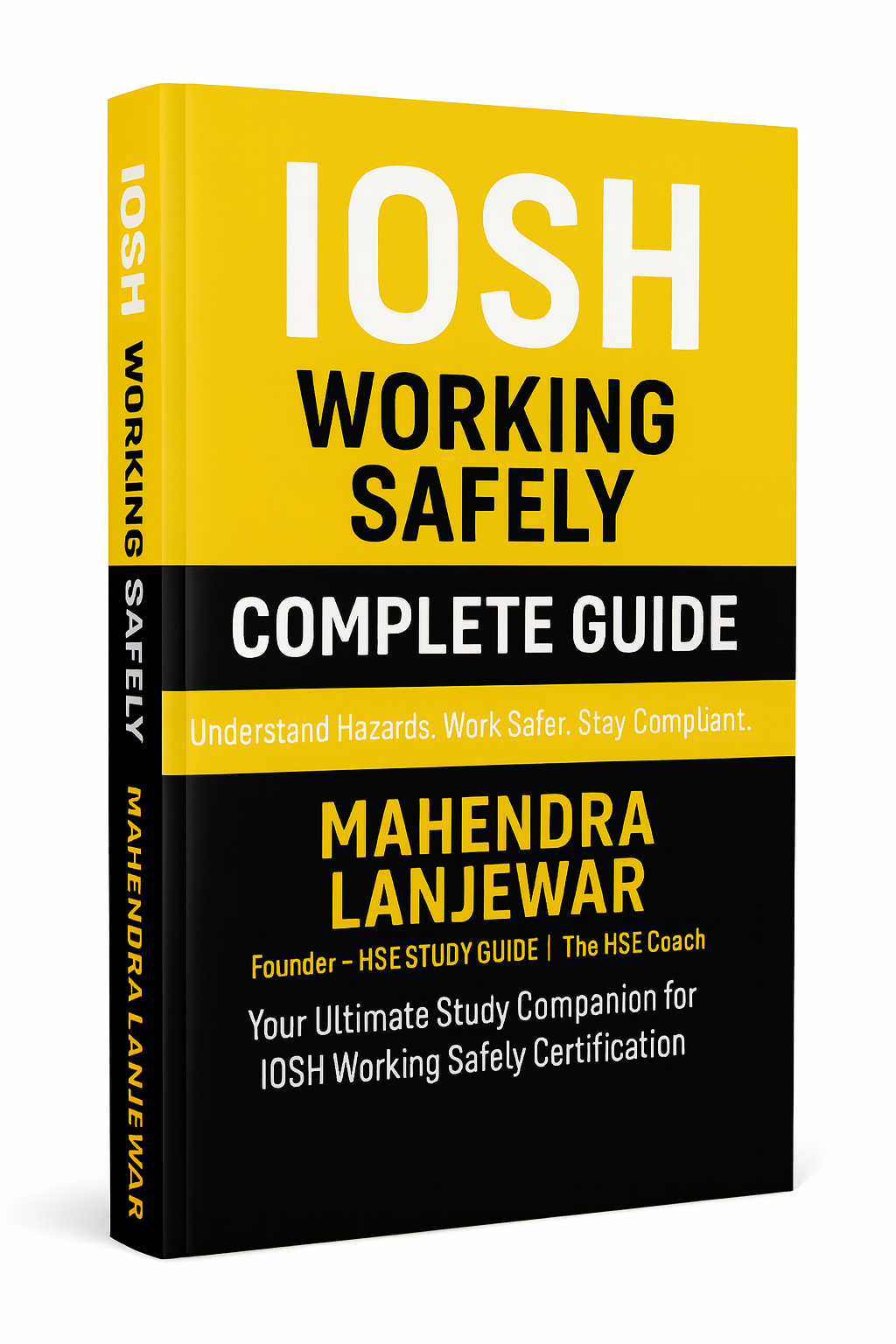
Introduction
If you’re considering a career in health and safety or aiming to advance your existing knowledge in the field, the NEBOSH International General Certificate (IGC) is an excellent certification to pursue. This globally recognized qualification equips professionals with essential skills and expertise to identify and manage workplace risks effectively. As you prepare for the NEBOSH IGC exam, it’s crucial to familiarize yourself with the types of questions you may encounter. In this article, we’ll cover some commonly asked NEBOSH IGC exam questions and provide detailed answers to help you in your exam preparation journey.
1. Understanding the NEBOSH IGC Exam Format
The NEBOSH IGC exam typically consists of two main units: Unit IG1 and Unit IG2. Unit IG1 focuses on management of health and safety, while Unit IG2 involves carrying out a practical risk assessment at your workplace.
2. Sample NEBOSH IGC Questions – Unit IG1
1: Describe the Hierarchy of Controls and Give an Example of Each Level.
The hierarchy of controls is a crucial concept in health and safety management. It provides a systematic approach to managing risks, starting with the most effective control measures. The five levels of the hierarchy are:
- Elimination: Completely removing the hazard from the workplace. Example: Replacing a hazardous chemical with a less harmful alternative.
- Substitution: Replacing the hazard with a less dangerous one. Example: Using non-toxic cleaning agents instead of harmful chemicals.
- Engineering Controls: Isolating workers from the hazard. Example: Installing ventilation systems to reduce exposure to fumes.
- Administrative Controls: Implementing policies and procedures to minimize risks. Example: Establishing safety protocols for working at heights.
- Personal Protective Equipment (PPE): Providing protective gear to employees. Example: Supplying workers with safety goggles when handling chemicals.
2: Explain the Purpose of a Health and Safety Policy and Outline Its Key Components.
A health and safety policy outlines an organization’s commitment to providing a safe working environment for its employees and visitors. The key components of a health and safety policy include:
- Statement of intent: Declaring the organization’s commitment to health and safety.
- Roles and responsibilities: Assigning specific duties to individuals for implementing the policy.
- Arrangements: Detailing how health and safety practices will be implemented and monitored.
- Legal compliance: Ensuring adherence to relevant health and safety laws and regulations.
- Continuous improvement: Demonstrating the commitment to ongoing enhancement of safety measures.
3: Describe the Key Elements of a Health and Safety Management System (HSMS).
A Health and Safety Management System (HSMS) is a comprehensive framework that helps organizations manage health and safety risks effectively. The key elements of an HSMS include:
- Policy: A written statement outlining the organization’s commitment to health and safety.
- Planning: Identifying hazards, assessing risks, and setting objectives and targets for improvement.
- Implementation: Putting the plans into action by assigning responsibilities and providing necessary resources.
- Measurement and Evaluation: Monitoring performance, conducting audits, and reviewing progress.
- Review and Continual Improvement: Regularly evaluating the HSMS to identify areas for enhancement.
4: What is the Purpose of a Job Safety Analysis (JSA) and How is it Conducted?
A Job Safety Analysis (JSA) is a systematic approach to identify and prevent workplace hazards associated with specific tasks. Its purpose is to enhance safety and reduce the risk of accidents and injuries. The steps to conduct a JSA are as follows:
- Select the Job: Choose a specific task or job to analyze.
- Break Down the Job: Divide the job into smaller steps or tasks.
- Identify Hazards: Identify potential hazards associated with each task.
- Assess Risks: Evaluate the likelihood and severity of each identified hazard.
- Implement Controls: Develop and implement control measures to mitigate risks.
- Communicate Findings: Share the JSA results with workers and provide necessary training.
3. Sample NEBOSH IGC Questions – Unit IG2
1: Conduct a Risk Assessment for the Task of Using a Ladder to Clean Gutters.
When conducting a risk assessment for the task of using a ladder to clean gutters, consider the following steps:
- Identify the hazards: Identify potential risks, such as falling from height or ladder instability.
- Identify the people at risk: Determine who may be exposed to the identified hazards.
- Evaluate the risks: Assess the likelihood and severity of each risk.
- Implement control measures: Take appropriate measures to reduce or eliminate the identified risks. For example, use ladder stabilizers and safety harnesses.
- Review and update: Regularly review and update the risk assessment as needed.
2: Perform a Risk Assessment for the Use of a Forklift in a Warehouse.
Conducting a risk assessment for using a forklift in a warehouse requires a systematic approach:
- Identify Hazards: Recognize potential risks, such as collisions, overloading, or pedestrian interactions.
- Identify People at Risk: Determine who may be exposed to the identified hazards.
- Evaluate Risks: Assess the likelihood and potential consequences of each risk.
- Implement Control Measures: Implement safety measures such as providing training, establishing traffic management, and using warning signs.
- Monitor and Review: Regularly monitor the effectiveness of control measures and update the risk assessment as needed.
3: Explain the Importance of Reporting Incidents and Near-Misses in the Workplace.
Reporting incidents and near-misses in the workplace is crucial for several reasons:
- Identifying Trends: It helps identify patterns and trends, allowing for targeted safety improvements.
- Preventing Recurrence: Understanding the root causes of incidents helps prevent similar occurrences in the future.
- Compliance: Reporting incidents ensures compliance with legal requirements and internal policies.
- Improving Safety Culture: Encouraging reporting fosters a proactive safety culture and empowers employees to participate in safety initiatives.
- Data Collection: Incident reports provide valuable data for analysis and decision-making.
Conclusion
The NEBOSH IGC certification is a valuable asset for professionals in the health and safety industry. By understanding and practicing the types of questions covered in the exam, candidates can increase their chances of success. Remember to study and prepare thoroughly to confidently tackle the NEBOSH IGC exam and demonstrate your expertise in ensuring workplace safety.
FAQs
Q1: Is the NEBOSH IGC certification globally recognized?
Yes, the NEBOSH IGC certification is recognized worldwide and highly respected in the health and safety industry.
Q2: Can I take the NEBOSH IGC exam online?
Yes, NEBOSH offers the option to take the IGC exam online for certain locations and under specific conditions.
Q3: What is the passing grade for the NEBOSH IGC exam?
To pass the NEBOSH IGC exam, candidates must achieve a minimum passing grade of 45 out of 100 marks for each unit.
Q4: How long is the NEBOSH IGC certification valid?
The NEBOSH IGC certification does not have an expiration date. However, continuous professional development is recommended to stay updated on industry best practices.
Q5: Are there any prerequisites for the NEBOSH IGC course?
No, there are no specific prerequisites for the NEBOSH IGC course. It is open to anyone interested in health and safety.
Q6: What are the benefits of holding a NEBOSH IGC certification for career advancement?
A NEBOSH IGC certification enhances your employability and demonstrates your commitment to workplace safety. It can open doors to a wide range of health and safety roles and potentially lead to higher job prospects and salary opportunities.
Q7: Can I retake the NEBOSH IGC exam if I fail?
Yes, candidates who do not pass the exam can retake it at a later date. NEBOSH allows multiple attempts to achieve a passing grade.
Q8: How long does it take to complete the NEBOSH IGC course?
The duration of the course varies depending on the training provider and study mode. Typically, it ranges from a few weeks to several months.
Q9: Is work experience required to apply for the NEBOSH IGC course?
No, work experience is not mandatory to enroll in the NEBOSH IGC course. However, practical experience can be beneficial in understanding real-world scenarios discussed during the training.
Q10: Can I use abbreviations in the NEBOSH IGC exam?
While it’s best to use full terms for clarity, some common abbreviations may be acceptable if widely recognized in the health and safety field. Always follow the guidelines provided by NEBOSH for using abbreviations in the exam.






















Good Afternoon,
Kindly send me newsletters to motivate me organize found for Nebosh IGI am keen interested to persue this program
this article was really helpful thanks waiting more update as prepare for the upcoming exam in
march
very helpful information
Great job, thanks.
i need to join with NEBOSH stud and exam
You have motivated me. I will take it
Ifeel motivated and empowered for taking Nebosh classes and studies
Iko aje
very helpful information
After going through the NEBOSH leaflets I found it very interesting and felt it is imperative for me to find out since I reside in South Africa in Limpopo province. How is the training going to be done if I am interested?
Can it be done online?
How are the courses structure fees?
I am a safety Manager
I am a safety Manager But I am a man of integrity and honesty